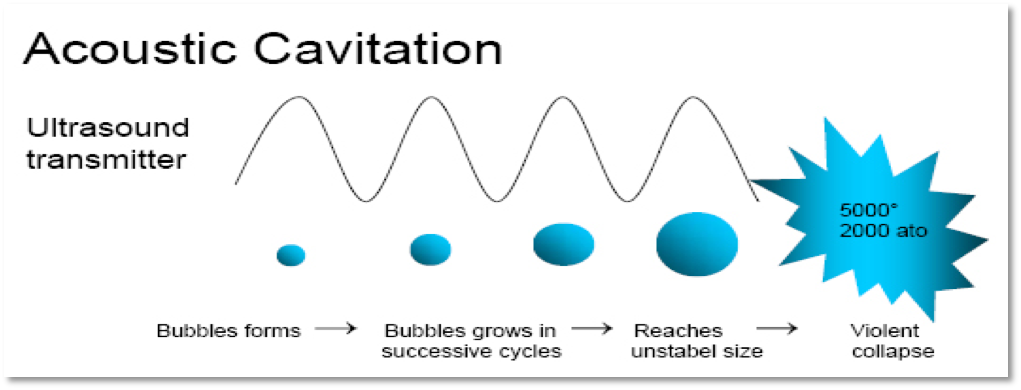
Cavitation basic for effective operation
The operation of USAF ™ is based on sonication and cavitation. Sonication is the sending of ultrasound by the transmitter. Cavitation is the formation of gas bubbles between the water molecules as a result of the strong emitted sound.
Explained in the literature study of the University of Utrecht called “Ultrasound as a sterilization method”, page 13.
Ultrasound as a sterilization method

The imploding of the gas bubbles creates very high pressure waves, up to 2000 atmospheres, that rupture the membranes of the micro-organisms.
This means the end of the micro-organism in question.
See the effect of USAF ™ channels on YouTube https://www.youtube.com/watch?v=xwuwO9wQ934&t=11s
With the right precautions, ultrasound is no problem for the materials of tanks and silos. Luijkx Ultrasound can advise you well.
The larger organisms such as the larvae of barnacles, oysters and mussels are expelled by the ultrasonic sound waves. As a result, they do not adhere to the protected parts such as ships or other underwater parts.
With high power ultrasound it is even possible to completely eliminate larvae or mites.
Biofilm
Biofilm control is essential in controlling pathogens in water storage, such as silos, tanks, ponds, pipes, etcetera.
The biofilm or biolayer is a slimy layer on the walls of water reservoirs. This biolayer consists mainly of mucus-producing bacteria. All kinds of fungi and viruses form part of this slime layer.
The bio-layer is essential in the multiplication of viruses, fungi and bacteria.
Viruses, fungi and bacteria in the water require a biolayer to multiply. They use this biolayer as a kind of nursery.
This is a continuously repeating process, which in the long run can lead to very high concentrations of micro-organisms (germs) in the water.
Keeping this bio-layer away makes it impossible for micro-organisms to multiply. This is a very important part in the control of micro-organisms.
If the pressure wave produced by the USAF ™ bounces off the wall or bottom of a silo, it will have a cleaning effect on this wall. This removes any biofilm that may have formed over time and prevents the formation of a new biofilm.
On page 32 of the literature study of the University of Utrecht called “Ultrasound as a sterilization method” it says, “Biofilms in particular are often a problem. These are thick and resistant colonies of bacteria. Sonication and cavitation are very effective in breaking up and loosening them. ”
USAF ™ in combination with another control method.
Combining other environmentally friendly techniques such as UV or hydrogen peroxide with USAF ™ will give a greatly improved result.
On pages 29 to 31 of the literature study “Ultrasound as a sterilization method”,
indicates which combinations are effective in combating pathogens.
Ultrasound as a sterilization method
Brief summary:
The combination of UV light and ultrasound is positive from the studies. This is because ultrasound breaks up colonies of pathogens and mixes the medium. This allows the UV light to reach the pathogens better. The pathogens are preprocessed by USAF ™ because the membranes rupture as a result of the pressure waves. The UV unit can then still give results with much less power. This makes the reduced effect of the UV as a result of pollution less important.
Antibiotics such as the environmentally friendly version of hydrogen peroxide (H2O2) in combination with ultrasound (USAF™) are also very effective.
USAF ™ tears the membranes of the pathogens, allowing the hydrogen peroxide to freely access and immediately and permanently kill the organism’s internal DNA.
The advantage of this is that the dosage can remain very low, because no H2O2 is needed to dissolve the membrane. Normally most of the H2O2 is used there.
These combinations gave excellent results when disinfecting flower bulbs.
Resistance cannot occur because USAF ™ is a mechanical means of control to which organisms cannot become resistant. Organisms are crushed by pressure waves.